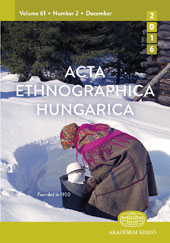GROWING OLD, BEING OLD. CONCEPTIONS (INNER AND OUTER VIEWPOINT) BEHIND THE NOTIONS OF OLD, ELDERLY
GROWING OLD, BEING OLD. CONCEPTIONS (INNER AND OUTER VIEWPOINT)BEHIND THE NOTIONS OF OLD, ELDERLY
Author(s): Tünde TuraiSubject(s): Cultural Anthropology / Ethnology, Evaluation research, Demography and human biology, Gerontology
Published by: Akadémiai Kiadó
Keywords: elderly; conceptions of old age; division of the life-course; contents of the old age; internal division of the old age;
Summary/Abstract: Along the 20th century, the position of the elderly has been being altered due to a very complex structural change regarding the economic, social and cultural life in Romania. These events of the macro-level had major effects on the micro-level. Collectivization, industrialization, the restructuring of the occupational sphere, urbanization and modernization brought about a massive geographic and social mobility, respectively changes in mentality and life-style. Focusing on the rural regions we can mention that the transfigurations within the hierarchy of the village, but especially the ones that occurred with respect to the institution of the family, put an end to the former foundations and frameworks, bringing other ones in lieu of them. My ethnological research focuses on the Transylvanian village of Bozies, where the process of growing old was enormous: in 1900 7.7% were aged 60 or above, in 1999 this number increased to 35.6%. As a consequence the social relationships, including both hierarchy and aspects of content, and thereupon the social attitudes have been redefined. After losing a considerable part of the economic, social, cultural and moral capital, the elderly have to face also the alteration of the contents of the concepts of aging, third generation, and being old. My paper is dedicated especially to these notions, i.e. to the analysis of the principles that govern the transfer from the second generation to the third one (the physiological boundary, the status of the grandparenthood, the marital status, the individual age influenced by the framing age of the milieu, the change of the dwelling- place, the habits of clothing, the pension as an economic resource, the changing of the range of work activities, the division of the moral roles) and to a detailed exposition of the internal division of the age bracket.
Journal: Acta Ethnographica Hungarica
- Issue Year: 53/2008
- Issue No: 2
- Page Range: 343-359
- Page Count: 17
- Language: English
- Content File-PDF

